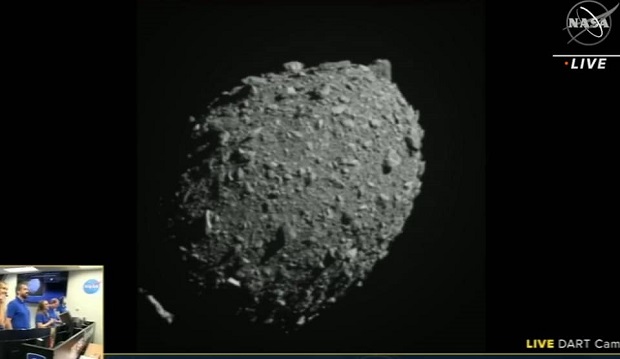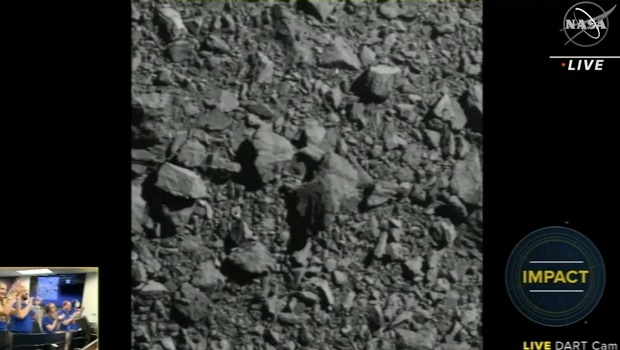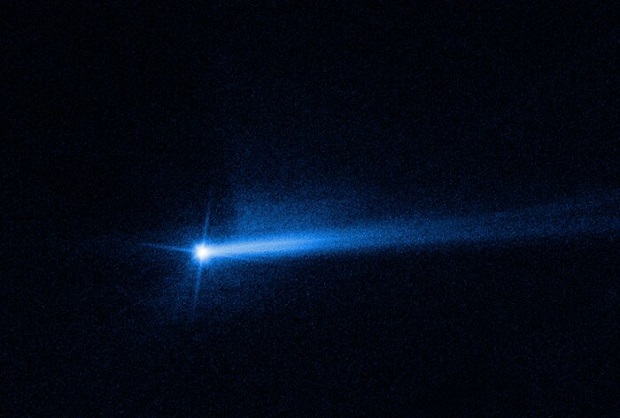
DART mission: What has been learned about Dimorphos asteroid?
The collision of a spacecraft with an asteroid cannot be called one of the standard methods of studying space objects, but in this particular case this collision was a necessity. On September 26, NASA's DART probe collided with Dimorphos asteroid to determine whether the spacecraft's impact could protect Earth from potentially dangerous space objects.
This mission gave scientists not only the answer to this question, but also information about the asteroid itself. There is still not much information, as scientists continue to study the data received from various sources. But let's try to understand what is already known today.
Dimorphos asteroid
Dimorphos is about 160 meters in diameter and orbits a larger asteroid called Didymos. Its diameter is about 780 meters.
Ahead of the DART mission's launch in November 2021, scientists studied the shapes of the two asteroids using a planetary radar that reflects the beam of radio waves they receive from them. Scientists didn't have much other information. But the camera installed on the DART changed everything. Shortly before the collision, the camera showed that the asteroid has a rocky surface covered with rocks and dust. However, the camera certainly couldn't show what was deep inside the asteroid—behind the outer rocks and dust.

Scientists were also surprised by the fact that Dimorphos, as it turned out, is oval; at least that's what it looked like from the angle the probe's camera was pointing at. The shape of the asteroid was much more "correct" than the scientists expected. Now they want to know what materials are on the asteroid and whether they can move—making the surface relatively round and flat.

As Space.com reports, more information about Dimorphos is likely to be obtained thanks to the European Space Agency's Hera mission. It will launch in 2024 on a SpaceX Falcon 9 rocket and reach Dimorphos two years later. The purpose of the mission will be to study calmly and without undue haste the asteroid and the consequences of the collision with the DART probe.
Giant Didymos
Less is known about Didymos, which Dimorphos orbits, because the asteroid quickly disappeared from the view of the DART cameras. But, in any case, there is interesting information about this asteroid.
As said by Carolyn Ernst, a planetary scientist at Johns Hopkins University Applied Physics Laboratory and DART mission technical specialist, even a cursory glance revealed that Didymos and Dimorphos are two different objects, despite their close proximity. Although some large rocks can be seen on Didymos, it still does not look like a giant pile of rocks like Dimorphos. The topography of Didymos shows more differences between flat and uneven areas compared to the seemingly homogeneous rock surface of Dimorphos.
All of these differences may help explain the occurrence of double asteroids, which account for about 15% of all asteroids around our planet. According to one theory, there is one main asteroid that rotates so fast that a part of it breaks off and becomes its satellite. According to another theory, when an asteroid flies very close to a large planet, the latter's gravity can detach a part of it from it, which then becomes a satellite of the asteroid.
Tail formed after impact
The collision with the DART probe formed a double tail of dust near the Didymos-Dimorphos asteroid system, which is clearly visible in the photo taken by the Hubble telescope.

Hubble observations showed that, as scientists expected, the cloud of dust and debris expanded and lost brightness over time, but between October 2 and 8, a tail appeared in the Didymos-Dimorphos system, which surprised scientists because such a thing is usually observed in comets and active asteroids.
- Related News
- Once in a lifetime phenomenon: This year we will observe a star explosion that occurred 3,000 years ago
- "AMADEE-24" Mars Analog Research Mission in Armash came to an end
- NASA creates new generation solar sail: What is it for?
- Flying object resembling surfboard was detected in Moon’s orbit: What is it in fact?
- Total solar eclipse on April 8, 2024: The most impressive photos
- Total eclipse of Sun will take place today: From which parts of the country will it be seen?
- Most read
month
week
day
- iPhone users are advised to disable iMessage: What risks are hidden in it? 1476
- Problems with Android 15: NFC contactless payments no longer work on smartphones with updated operating systems 1179
- Pavel Durov gives interview to Tucker Carlson: From 3-hour interview, less than hour appears in final version 1097
- AMD Ryzen 7 processor, 24 GB of RAM and only $550: Mechrevo presents inexpensive and powerful laptop (photo) 825
- Black Shark smart ring from Xiaomi to have interesting characteristics and phenomenal autonomy: 180 days of operation without recharging (photo) 787
- The 5 most controversial buildings ever built: Bold design or complete failure? (photo) 785
- Armenia takes 89th place in terms of mobile Internet speed, but leads region in terms of fixed line speed 701
- 3 best smartphones under $160 665
- Telegram receives major update and sticker editor 649
- No internet access required? How AI will work in iPhone 570
- Archive
